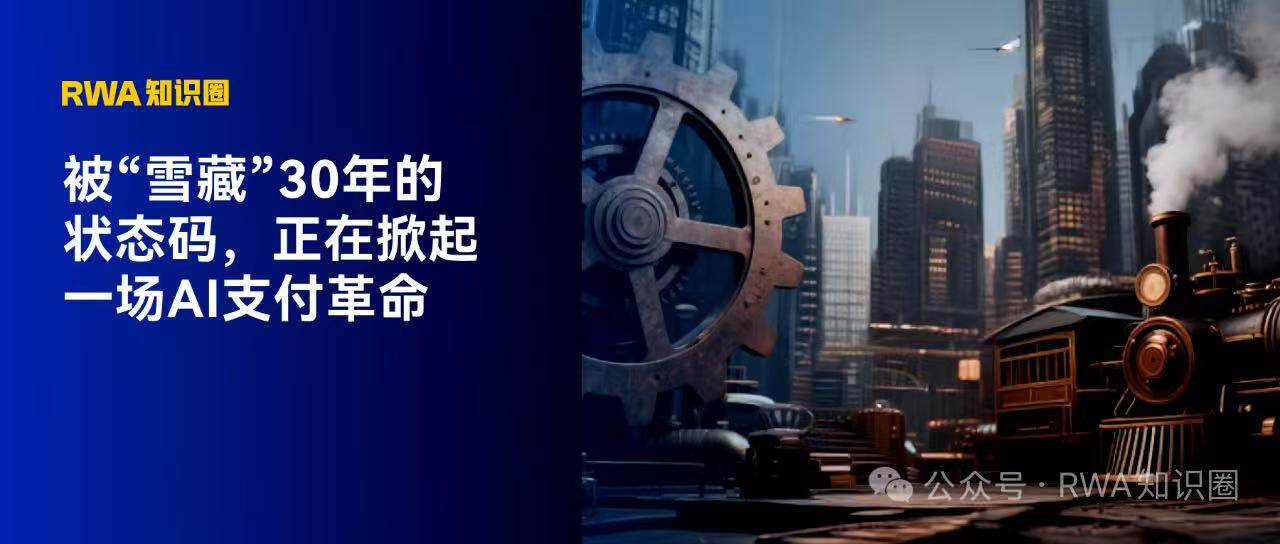Status codes, which have been "hidden" for 30 years, are now sparking an AI payment revolution.
- 核心观点:x402协议重启HTTP 402,实现自动结算。
- 关键要素:
- 稳定币与Rollup降低微支付成本。
- AI代理成为自主经济个体。
- 支持机器间实时按需交易。
- 市场影响:推动互联网向机器经济网络演进。
- 时效性标注:长期影响

I. A Mysterious Code from 30 Years Ago
Thirty years ago, the HTTP protocol contained a mysterious line of code that was never used—402 Payment Required.
Its meaning is simple: when you access a resource, if payment is required, the server will return a 402 status code, telling you the amount to pay, the type of asset, the receiving address, etc.
Imagine that while you're browsing the web, watching videos, or using AI models, the system automatically completes the payment as soon as a request is triggered, without needing to log in or enter a password—everything is done seamlessly in the background.
This is the vision of 402—to give the internet the ability to “automatically settle accounts”.
Strangely, this status code remained dormant for a full thirty years after it was proposed.
Why has such a futuristic design never been brought to fruition?
The answer lies in the evolution of payment infrastructure and AI.
A reboot two or three decades later: The perfect encounter between AI and payment.
A piece of code that had been shelved has finally found its place.
Over the past few years, the underlying conditions of the internet have undergone fundamental changes:
- Stablecoins have become "native internet currencies," allowing machines to directly hold and settle value.
- Low-cost Rollup and high-performance settlement chain make micropayments truly "cost-effective," with transaction fees as low as one-thousandth of a cent.
- AI agents are transforming from tools into "economic entities," proactively purchasing services, calling upon models, and generating revenue.
When these conditions come together, value can finally flow freely on the internet like data.
Therefore, in May 2025, Coinbase launched the x402 protocol—a standard that revived the "payment request" status code, giving the internet the ability to "automatically settle" for the first time.
Just as HTTP in 1993 enabled the internet to transmit web pages, x402 today enables the internet to transmit value.
III. The Era of Real-Time Trading with AI and APIs
x402 transforms machine-to-machine business transactions from "manually triggered" to "protocol-native":
① On-demand access, instant payment
AI agents can make real-time payments to obtain access to data or models without an API key or payment.
for example:
- Research-based AI automatically pays for each instance of accessing market data.
- During model training, proprietary information is unlocked based on retrieval volume.
② Automation of infrastructure consumption
- Computing power, bandwidth, and storage can all be billed on a per-use basis:
- Automatic billing for each GPU inference attempt;
The decentralized model settles accounts based on the number of calls, rather than a subscription model.
③ Machine-to-machine autonomous transactions
- AI characters in the game automatically purchase resources;
- IoT devices automatically pay for bandwidth and sensor data.
All of this is transforming the internet from an "information network" into a "machine economy network."
A market system composed of countless intelligent agents that can negotiate, trade, and settle transactions on their own.
IV. Giants Bet on X402: Becoming the "Payment Foundation" of the AI Economy
This is not just hype; several tech and financial giants are already taking action:
- Coinbase: the originator of the x402 protocol and the official operator of Base L2, with the goal of creating value settlement infrastructure for "proxy networks".
- Google: Introduces A2A x402 extension, enabling AI agents to complete a full closed loop from "task discovery → negotiation → payment → delivery".
- a16z: One of the top venture capital firms, heavily invested in the "agency-based business" sector, believing that the x402's speed, cost, and programmability surpass Visa and SWIFT in every aspect.
The entry of major players means that "machine-to-machine economy" is no longer just a concept, but the starting point of the next form of internet economy.
V. Data Doesn't Lie: The Real Performance of the X402
Based on on-chain data, x402 is not an empty narrative.
- The ecosystem recorded a total of 2,593,100 payments, amounting to approximately US$2,936,900.
- The average payment was only $1.13, which perfectly matches the characteristics of "high frequency and small amount" micro-payment;
- Currently, there are approximately 137,800 buyers and 20,000 sellers, a ratio of about 7:1, indicating that the ecosystem has already reached a certain two-sided market scale.
- With a total market capitalization of approximately $822 million and a 24-hour trading volume of approximately $203 million, it has extremely high liquidity.
These data demonstrate that there is indeed a large amount of real-world demand in the x402 network, especially in the areas of micropayments and AI applications.
However, it should also be noted that the growth rate of market valuations has significantly outpaced the actual scale of usage.
It may be the starting point of the next "AI + Web3 bubble", or it may be the foundation of a new era of internet payment.

VI. From 402 to the Future: Opportunities Lie in the Overlooked Corners
A status code forgotten for thirty years has reignited global discussion, and the lessons behind it are actually quite real:
Some opportunities do exist, but they simply need to wait until the infrastructure is mature and the understanding is in place.
Today, technologies such as AI, blockchain, and RWA are at the same turning point.
For us, continuously learning and understanding these underlying logics is not just about "following the trend".
Rather, it's about preparing for future inspiration—
Perhaps one day, you too can discover a new business opportunity from a line of old code.
💡 Conclusion:
x402 is not simply a "payment agreement"; it shows us a whole new internet:
An economy composed of machines that can trade autonomously and settle transactions in real time.
And this may be the starting point for the true integration of the next generation of RWA, AI and on-chain finance.



